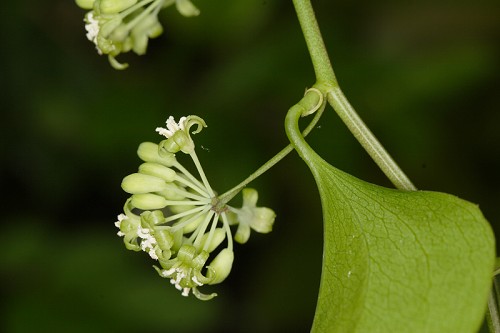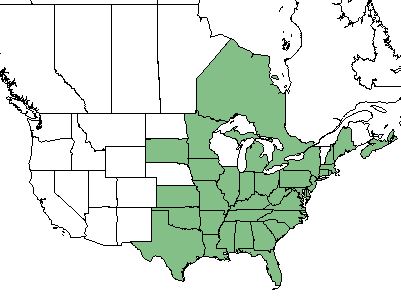Difference between revisions of "Smilax rotundifolia"
(→Distribution) |
|||
| Line 23: | Line 23: | ||
<!-- Basic life history facts such as annual/perrenial, monoecious/dioecious, root morphology, seed type, etc. --> | <!-- Basic life history facts such as annual/perrenial, monoecious/dioecious, root morphology, seed type, etc. --> | ||
==Distribution== | ==Distribution== | ||
| + | The distribution of ''S. rotundifolia'' ranges from eastern Texas, westward to northern Florida, and northward into the provinces of Nova Scotia and Ontario Canada.<ref name="Weakley 2015"/> | ||
| + | |||
==Ecology== | ==Ecology== | ||
===Habitat=== <!--Natural communities, human disturbed habitats, topography, hydrology, soils, light, fire regime requirements for removal of competition, etc.--> | ===Habitat=== <!--Natural communities, human disturbed habitats, topography, hydrology, soils, light, fire regime requirements for removal of competition, etc.--> | ||
Revision as of 20:01, 22 January 2018
| Smilax rotundifolia | |
|---|---|

| |
| Photo by John Gwaltney hosted at Southeastern Flora.com | |
| Scientific classification | |
| Kingdom: | Plantae |
| Division: | Magnoliophyta - Flowering plants |
| Class: | Liliopsida - Moncots |
| Order: | Liliales |
| Family: | Smilacaceae |
| Genus: | Smilax |
| Species: | S. rotundifolia |
| Binomial name | |
| Smilax rotundifolia L. | |

| |
| Natural range of Smilax rotundifolia from USDA NRCS [1]. | |
Common Names: Common greenbriar; bullbriar; horsebriar[1]
Contents
Taxonomic Notes
Description
Distribution
The distribution of S. rotundifolia ranges from eastern Texas, westward to northern Florida, and northward into the provinces of Nova Scotia and Ontario Canada.[1]
Ecology
Habitat
S. rotundifolia is found in a variety of upland and wetland habitats.[1]
Phenology
In the southeastern and mid-Atlantic United States, S. rotundifolia flowers from April through May with fruiting occurring in September through November and persisting beyond.[1]